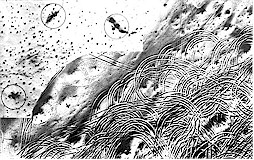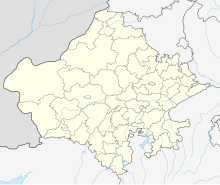| Battle of Longewala | |||||||
|---|---|---|---|---|---|---|---|
| Part of the Indo-Pakistani War of 1971 | |||||||
 Tank tracks at Longewala. Photographic reconnaissance image taken at the time showing the desperate last-minute manoeuvres by Pakistani tanks in the Longewala sector. Circles show destroyed Pakistani tanks. | |||||||
| |||||||
| Belligerents | |||||||
|
|
| ||||||
| Commanders and leaders | |||||||
| Units involved | |||||||
| |||||||
| Strength | |||||||
|
1 Company (120 personnel) accompanied by half a platoon (6-7 border guards)[5][6] |
2 Mobile infantry brigade (2,000–3,000 personnel)[8][9] | ||||||
| Casualties and losses | |||||||
|
2 personnel killed[10][11] |
200 personnel killed[10] | ||||||
Location within Rajasthan | |||||||
The Battle of Longewala (4–7 December 1971) was one of the first major engagements in the western sector during the Indo-Pakistani War of 1971, fought between assaulting Pakistani forces and Indian defenders at the Indian border post of Longewala, in the Thar Desert of Rajasthan. The battle was fought between 120 Indian soldiers accompanied by four Hawker Hunter and three HAL Marut fighter-bombers and 2,000–3,000 Pakistani soldiers accompanied by 30–40 tanks.
A company of the Indian Army's 23rd Battalion, Punjab Regiment, commanded by Major Kuldip Singh Chandpuri a Sikh Gujjar, was left with the choice of either attempting to hold out until reinforced, or fleeing on foot from a Pakistani mechanized infantry force.[12] Choosing the former, Chandpuri ensured that all his assets were correctly deployed and made the best use of his strong defensive position, as well as weaknesses created by errors in enemy tactics. He was also fortunate that an Indian Air Force forward air controller was able to secure and direct aircraft in support of the post's defence until reinforcements arrived six hours later.[13]
The Pakistani commanders made several questionable decisions, including a failure of their strategic intelligence to foresee the availability of Indian fighter-bombers in the Longewala area, exercising operational mobility with little or no route reconnaissance, and conducting a tactical frontal assault with no engineer reconnaissance.[14][13] That led to the Pakistani brigade group being left extremely vulnerable to air attack and vehicles becoming bogged in terrain unsuitable for the movement of armoured vehicles, as they tried to deploy off a single track and were more susceptible to enemy fire since they used external fuel storage in tactical combat and attempted to execute a night attack over unfamiliar terrain, and infantry was surprised by obstacles to troop movement, which caused confusion and stalling the attack during the crucial hours of darkness, when the assaulting infantry still had a measure of concealment from Indian small arms and infantry support weapon fire.[14]
- ^ p. 1187, IDSA
- ^ Lal, Pratap Chandra (1986). My Years with the Iaf. Lancer International. ISBN 978-81-7062-008-2. Retrieved 6 July 2013.
- ^ https://www.bharat-rakshak.com/IAF/Database/4692 [bare URL]
- ^ "1971 War Hero Bhairon Singh Rathore, Who Inspired Many To Serve The Country, Cremated With Full State Honours". 20 December 2022.
- ^ "1971 India-Pakistan war | Bhairon Singh Rathore, hero of Longewala, passes away in Jodhpur at 81". The Hindu.
- ^ Karl R. DeRouen; Uk Heo (2007). Civil Wars of the World: Major Conflicts Since World War II. ABC-CLIO. pp. 101–. ISBN 978-1-85109-919-1.
- ^ James Hattar. "Taking on the enemy at Longenwala". The Tribune.
- ^ DeRouen, Karl R. (2007). Karl R. DeRouen, Uk Heo (ed.). Civil Wars of the World. ABC-CLIO. p. 596. ISBN 978-1851099191.
- ^ a b c Jaques, Tony (2007). Dictionary of Battles and Sieges: A Guide to 8,500 Battles from Antiquity Through the Twenty-First Century. Greenwood. p. 597. ISBN 978-0313335389.
- ^ a b c d Col J Francis (Retd) (30 August 2013). Short Stories from the History of the Indian Army Since August 1947. Vij Books India Pvt Ltd. pp. 93–96. ISBN 978-93-82652-17-5.
- ^ "1971 war hero gives hour-by-hour account of the battle of Longewala". Asianet News Network Pvt Ltd. Retrieved 17 August 2020.
- ^ "The Tribune – Windows – Featured story". tribuneindia.com. Retrieved 2 August 2016.
- ^ a b Singh, Harvijay. "Battles that Made History – Defstrat". www.defstrat.com. Retrieved 5 June 2023.
- ^ a b "The 1971 Battle of Longewala: A night of confusion, Sam Manekshaw's order, Pakistan's folly". ThePrint. 3 December 2019.
